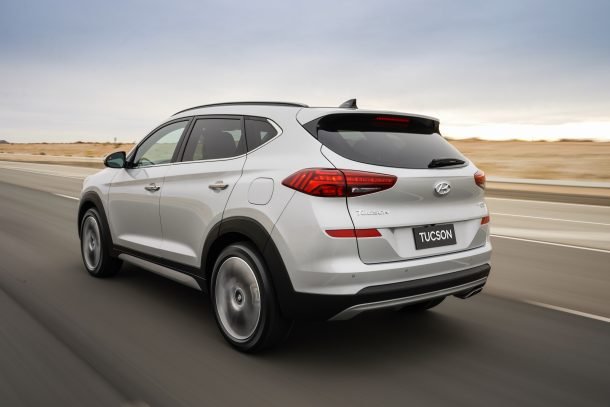2019 Hyundai Tucson: There's No Replacement for Displacement, It Seems

The radically mildly refreshed 2019 Hyundai Tucson, unveiled Wednesday at the New York International Auto Show, might not attract stares and selfies in the same way as the show’s more exotic sheetmetal, but it’ll sure draw buyers to the showroom.
Hyundai needs to collect those buyers. Amid a sales slump it hopes to remedy with an onslaught of crossovers, the compact Tucson crossover is one of the automaker’s largest meal tickets. Sales rose 31 percent, year over year, in the U.S. last month. And, while the Elantra and Santa Fe boast larger sales volumes, the Tucson has the best growth rate — sales are up 32.1 percent over the first two months of 2018.
To reward the buying public for their continued support, Hyundai has made changes to the 2019 model. Who wants a larger engine?
The report we brought you earlier this month panned out, but with a catch. Yes, the 2019 Tucson will indeed offer a 2.4-liter four-cylinder as an upgrade over its base 2.0-liter powerplant, but it comes at the expense of the turbocharged 1.6-liter four. That engine drops from the Tucson catalogue for 2019.
Opting for the 2.4 brings 181 horsepower and 175 lb-ft of torque to the equation, a move up from the 2.0-liter’s 164 hp and 151 lb-ft. Both engines meter out the power through a six-speed automatic.
For 2019, a Sport trim joins the Tucson stable, positioned between SEL and Limited. These three trim levels see the 2.4-liter, whereas the base and SE models stick with the smaller mill. As we told you before, going Sport adds appearance and content upgrades, as well as 19-inch wheels — up an inch from the SEL’s donuts and two inches from lesser trims. The Limited gains extra chrome trim because people like that sort of thing.
Looks-wise, changes are subtle to say the least. A very slightly revised grille, front fascia, and headlamp design will forgive you if you fail to notice any difference, and the interior greets you with an altered center stack and gauge cluster. For the coming model year, forward collision-avoidance assist (automatic emergency braking) and lane keeping assist joins the roster of standard features. Rear seat passengers in SEL models will discover a new USB port, while backseat denizens of the Limited model gain a wireless charging pad.
Hyundai hasn’t released a price list just yet.
So, there you have it. More trim choice, more available horsepower, less available torque, and design changes that won’t offend the faithful. We’d be shocked if the Tucson didn’t have another record year.
[Images: Hyundai]

More by Steph Willems
Latest Car Reviews
Read moreLatest Product Reviews
Read moreRecent Comments
- Lou_BC Well, I'd be impressed if this was in a ZR2. LOL
- Lou_BC This is my shocked face 😲 Hope formatting doesn't fook this up LOL
- Lou_BC Junior? Would that be a Beta Romeo?
- Lou_BC Gotta fix that formatting problem. What a pile of bullsh!t. Are longer posts costing TTAC money? FOOK
- Lou_BC 1.Honda: 6,334,825 vehicles potentially affected2.Ford: 6,152,6143.Kia America: 3,110,4474.Chrysler: 2,732,3985.General Motors: 2,021,0336.Nissan North America: 1,804,4437.Mercedes-Benz USA: 478,1738.Volkswagen Group of America: 453,7639.BMW of North America: 340,24910.Daimler Trucks North America: 261,959




































Comments
Join the conversation
I've never really paid much attention to this segment, yet there are so many on the road. I just did a quick search to see what we have in Australia and was amazed that there are 32 competing vehicles in this segment of mid-sized SUVs (Aussie). These are the mid-size sedan/car killers. https://www.carsguide.com.au/suv/midsize-suvs
Actually don't care for the (minor) exterior changes, but the interior/dash gets a much needed major rework.